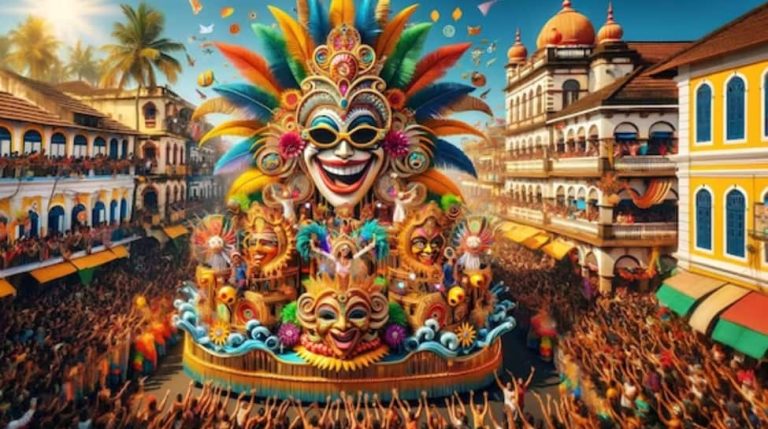This traditional Hindu festival Shigmotsav marks the arrival of spring and is celebrated with great enthusiasm. The festival is scheduled to be held from March 26 to April 8 in the entire state, and will come alive with cultural performances, float parades, traditional music and dance during Shigmo.
While Shigmu's colors liven up the streets, many other festivals are gearing up to showcase their diverse cultural heritage through a series of unique festivals. These festivals embody the essence of Goan tradition, each offering a distinct experience for travelers seeking to delve into the spirit of this coastal paradise. Watch a journey through five extraordinary festivals that add a splash of color and a touch of excitement to the celebrations along with Shigmu in Goa.
Xenni Uzzo at Molcornem Sanguem, Embracing Goa's Fire Ritual: Xenni Uzzo stands out as an exciting fire ritual in South Goa. Annually, on the first full moon night after Shigmo, the village of Mulkornam in Quepem, Goa, becomes the scene of a distinctive and ancient ceremony known as Zeni Ozo. These rituals serve a dual purpose: they honor the village's founding figures and beliefs while also commemorating the spring harvest festival.
Despite the rapid pace of modernization, the people of Mulkornem maintain a deep respect for their traditional customs, which is particularly evident during the Shini Ozo period. Using natural resources, such as dried cow dung cakes, locally called “Xenni”, and leaves, they generate sparks, referred to as “Uzzo”, by striking these items together. Encircling the resulting fire, the villagers engage in lively dances, while the men transport areca nut tree trunks from carefully selected plantations near the Mallikarjun Temple.
Gudi Mudni in Thane, Sattari, a spectacle of horses and warriors: Gudi Mudni, meaning 'Horse Dance', is a unique festival celebrated in villages of Thane, Sattari and elsewhere. This centuries-old tradition showcases a spectacular display of equestrian and martial arts, with performers dressed as warriors riding ornate horses. The rhythmic sound of hooves and the colorful clothes of the performers create an enchanting spectacle that captivates the audience's attention. The Ghode Modni folk dance features as one of the highlights of the Shigmo festival celebrated during the harvest season in Goa. Etymologically, “Ghode” translates to “horse”, while “Modni” means “delightful”, which sums up the essence of the performance.
Chorotsav in Zarmi, Magic of Goan Villages Revealed: Chorotsav, also known as the 'Festival of Thieves', is an exotic celebration held in Zarmi village in Sattari taluka. This unconventional festival pays homage to the folk heritage of Goan villages, where locals dress up as mischievous thieves and engage in playful antics. From mock robberies to comedy shows, Chorotsav offers a hilarious glimpse into the humor and creativity of Goan culture.
At the festival, four participants are buried with only their heads visible, while the heads of four others are immersed in pits. This symbolic act represents a tragic incident from past centuries when thieves were mistakenly executed. The spectacle attracts a crowd of locals and interested onlookers, who watch with a mixture of fascination and anticipation as the eight individuals are buried alive.
The fiery ritual of Homkund Utsav at Charao, a spectacle of devotion and tradition: In the quaint village of Charao, nestled amidst the lush greenery of Goa, the Homkund Utsav takes on a fiery intensity, offering a unique spectacle of devotion and tradition. Here, amid tranquil surroundings, locals gather to perform ancient rituals to honor their ancestors and seek blessings for prosperity and well-being.
The festival entails lighting a pyramidal pile of wood, usually about five to six feet high. Once the wood is reduced to smoldering ash, local men and boys participate in a fascinating ritual, traversing barefoot across the burning embers to the rhythmic accompaniment of traditional percussion instruments such as the dhol, tasha, and cymbals. This energetic and glamorous event witnesses the participation of hundreds of individuals as they bravely walk the fiery path.
Sheesha Rani in Canacona: Where Devotion Cooks Blessings on the Fire: Sheesha Rani is a traditional festival deeply rooted in Goan culture in Canacona. During this ritual, rice is cooked over the heads of three Gadis, which are human representations of divinity on Earth. Interestingly, the term “rani” directly translates to “burner”, which emphasizes the central element of this ceremony.
In a remarkable show of dedication, three villagers from Gaundungorim in Kanacona taluka voluntarily offered their heads as makeshift stoves to cook rice over a wood fire.
From the colorful splendor of Shigmo to the alluring magic of village festivals, Goa offers a variety of cultural experiences for visitors to explore. Whether you are mesmerized by the vibrant rhythms of traditional music or seduced by the exciting flavors of Goan cuisine, these unique festivals promise magic and delight at every turn. So pack your bags, indulge in the festivities and embark on a journey of discovery through the vibrant fabric of Goa's culture. Visit Goa tourism website for more information https://goatourism.gov.in/

